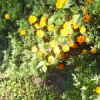
I was reading information about making soap products someone had posted on ThriftyFun. Is it possible to make nice soap i.e., glycerin without using lye? As I have never tried to make soap, I wondered if it there was a way to do this. Many thanks. Helen xx
By helen from U.K
Add your voice! Click below to answer. ThriftyFun is powered by your wisdom!

Making Soap without using Lye.
One of the questions commonly asked during soap making discussion is "can I make soap without having to use lye". The answer is a simple YES and NO. NO your can't make soap from oils and fats without lye but YES you can make soap quite easily using melt and pour glycerine soap or soap noodles.
Lye is absolutely necessary to convert oils and fats to soap. During this process many companies extract the glycerine and resell it to crafters wanting to make what is called Melt and Pour soaps. Other companies take soap made with lye and shave it into noodles so that it can be melted or rebatched into soap bars by crafters. In other words crafters and hobbyists who want to safely make soap can simply skip the step where lye is used and still enjoy the soapmaking process. Another advantage to melt and pour soapmaking is that you get a more consistant product. There is less risk of creating a bad batch of soap. Purists would call this cheating but if you want to have fun making soap and do not want to deal with the dangers then it is just a smart choice.
Here are some basic instructions on making soap using either glycerine melt and pour soap base or soap noodles.
Step 1: Place the amount of soap base that you wish to process into a double boiler. A crock pot on low will also work. Melt the base covered over a low heat so that moisture does not escape and so that the soap base does not get too hot. Gently stir the glycerine soap base or soap noodles but try not to whip air into the mix. In other words stir as little as possible.
Step 2: Gently stir in your additives including colorant, herbs, fragrances, vitamins, cocoa butter, aloe vera, etc.. It is best to purchase these items from companies who make them for soap. Especially the colorants and fragrances. Add these items one at a time starting with colors, then moisturizers or vitamins and then finally fragrances. Stir gently.
TIP - when using solid additives like cocoa butter you will want to melt those separately and then pour them into your soap.
Step 3: Pour your mixture into molds. You can use just anything you wish as a mold as long as you can get the soap back out.
Step 4: After your soap has hardened unmold it. Your freshly made soap can be used immediately. good luck.
Making a lot of soap each week is a rewarding hobby that turned into a business for me. So yes, I make a lot of soap. The soap that I make requires lye in every batch.
I could make soap using melt and pour soap bases and not have to handle the lye. Why don't I do the melt and pour bases? Read the ingredients in those bases. There are very few melt and pour bases that do not contain some pretty nasty chemicals and additives.
Making my own goat milk soaps with a good recipe can make some great all natural soaps. In my natural soaps I include olive oil for moisturizing properties, coconut oil for the cleansing and nutrients, castor oil for great fluffy lather, shea butter for the moisturizing properties and nutrients, Tussah silk for that great feel in the bar of soap, Kaolin clay to help refine the skin and help to detoxify the skin, some bars have honey in them to feed the collagen in the skin, some bars have essential oils in them for the great benefits they bring to the soap, colorants and micas to make the soaps pretty so that people will visually enjoy the soaps.
Read the ingredients on the melt and pour bases available. Are they nice and pure? Remember, those melt and pour soaps also started with lye. The lye is now saponified into soap but it was there, just like in my hand crafted bars. Do you really want to put just any chemical on the largest organ (skin) of your body?
If you don't think that soap matters, try stepping on a clove of garlic with your bare heel. Notice how fast you taste garlic in your mouth? Way too fast to mess with any chemicals in your soaps.
Add your voice! Click below to answer. ThriftyFun is powered by your wisdom!